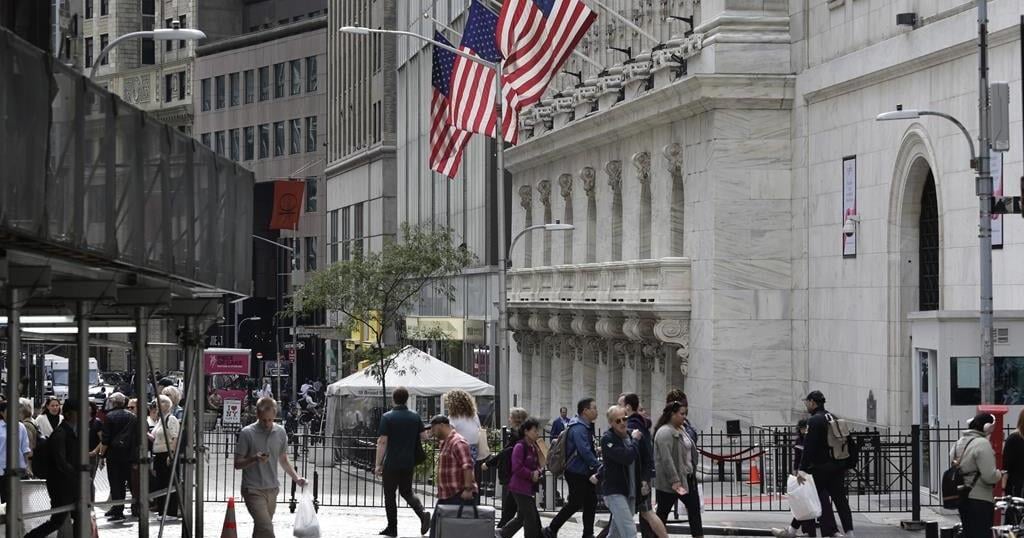NEW YORK (AP) — U.S. stocks are drifting lower, as crude oil prices continue to climb. The S&P 500 was down 0.2% in early trading Thursday following a shaky run where worries about worsening tensions in the Middle East knocked the index off its record. The Dow Jones Industrial Average was down 192 points, or 0.4%, and the Nasdaq composite was off 0.2%. Oil prices rose about another 2% as the world continues to wait to see how Israel will respond to Iran’s missile attack from Tuesday. Treasury yields rose after a report suggested the number of layoffs across the country remain relatively low.
THIS IS A BREAKING NEWS UPDATE. AP’s earlier story follows below.
Wall Street tipped toward small losses early Thursday ahead of some labor market reports that will be closely analyzed by the Federal Reserve as it shifts its focus from inflation toward supporting the broader economy.
Futures for the S&P 500 were 0.1% lower before the bell, while futures for the Dow Jones Industrial Average slipped 0.2%.
The dominant question hanging over Wall Street has been whether the job market can keep holding up after the Federal Reserve earlier kept interest rates at a two-decade high. The Fed was trying to press the brakes hard enough on the economy to stamp out high inflation.
Stocks are near records in large part on the belief that the U.S. economy will continue to grow now that the Federal Reserve has begun cutting interest rates. The Fed last month lowered its main interest rate for the first time in more than four years and indicated more cuts will arrive through next year.
Coming later Thursday is the Labor Department’s unemployment benefits report, which broadly represents the number of U.S. layoffs in a given week. Layoffs have remained historically low, though started ticking higher beginning in May.
Treasury yields rose after a report Wednesday by ADP Research indicated that hiring by U.S. employers outside the government may have been stronger last month than expected.
That could auger well for the government’s more comprehensive report on the U.S. job market due out Friday, the first since the Fed cut its benchmark lending rate by half a point last month.
Levi shares tumbled 12% in premarket trading after the maker of blue jeans came up short on sales projections and trimmed its fourth-quarter outlook. CEO Michelle Gass said the company was working to address areas of underperformance, including “strategic alternatives” for its Dockers brand.
In German at midday, Germany’s DAX shed 0.3% while the CAC 40 in Paris gave up 0.5%. In London, the FTSE 100 gained 0.4%.
The U.S. dollar gained against the Japanese yen as officials indicated that conditions were not conducive for an interest rate hike.
That helped push Tokyo’s Nikkei 225 index higher. It gained 2% to 38,552.06, while the dollar traded at 146.67 Japanese yen, up from 146.41 yen late Wednesday.
A weaker yen is an advantage for major export manufacturers like Toyota Motor Corp. and Sony Corp.
The dollar had been trading around 142 yen after the ruling Liberal Democrats chose Shigeru Ishiba to head the party and succeed Fumio Kishida as prime minister. Ishiba, who took office on Tuesday, had expressed support for the central bank’s recent moves to raise its near-zero benchmark interest rate, which stands at around 0.25%. That led traders to bet that the yen would gain in value.
But after a meeting between Ishiba and Bank of Japan Gov. Kazuo Ueda, both officials indicated that the central bank did not view further rate hikes as suitable for the economy at this time. That prompted a flurry of selling of yen, which benefits big export manufacturers.
Elsewhere in Asia, Hong Kong’s Hang Seng dropped 1.5% to 22,113.51 as investors sold shares to lock in profits after the benchmark roared 6.2% higher a day earlier on a wave of investor enthusiasm over recent announcements from Beijing about measures to rev up the slowing Chinese economy.
With Shanghai and other markets in China closed for a weeklong holiday, trading has crowded into Hong Kong. Markets in South Korea and Taiwan also were closed on Thursday. India’s Sensex fell 2.1%.
Oil prices rose again as the world waited to see how Israel will respond to Tuesday’s missile attack from Iran.
U.S. benchmark crude oil gained $1.09 to $71.19 per barrel in electronic trading on the New York Mercantile Exchange. Brent crude, the international standard, was up $1 to $74.90 per barrel.
Israel is not a major producer of oil, but Iran is, and a worry is that a broadening war could affect neighboring countries that are also integral to the flow of crude.
Also early Thursday, the euro fell to $1.1042 from $1.1047.
